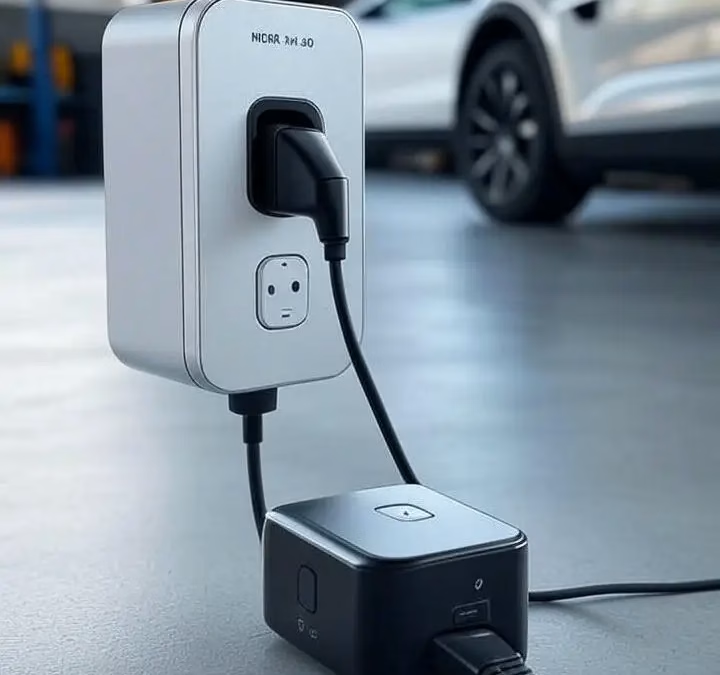Electric vehicles (EVs) are becoming increasingly popular, and with that comes the need to understand the infrastructure that powers them. Two terms that often cause confusion are EV receptacle and EV charger. While they both play a role in charging an electric vehicle, they are not the same thing. In this blog post, we’ll break down the differences to help you navigate EV charging with confidence.
What is an EV Receptacle?
An EV receptacle is essentially an electrical outlet designed to supply power to an EV charging system. It’s the wall-mounted socket where you plug in an EV charger or, in some cases, a portable charging cable. Think of it as the interface between your home’s electrical system and the charging equipment.
Key Features of an EV Receptacle:
- Purpose: Provides a connection point for delivering electricity to an EV charger or cable.
- Types: Common EV receptacle types include NEMA 14-50 (240V, 50A) and NEMA 6-50 (240V, 50A), though specific requirements depend on the charger or vehicle.
- Installation: Requires professional installation by an electrician to ensure it meets electrical codes and can handle high voltage and amperage safely.
- Use Case: Often used for Level 2 charging at home, where a portable EV charger is plugged into the receptacle.
EV receptacles are passive components—they don’t control or manage the charging process. They simply deliver raw electrical power to the device plugged into them.
What is an EV Charger?
An EV charger, also known as Electric Vehicle Supply Equipment (EVSE), is the device that manages and delivers electrical power to the vehicle’s battery in a controlled and safe manner. The charger can either be a portable unit that plugs into an EV receptacle or a hardwired unit permanently installed on a wall.
Key Features of an EV Charger:
- Purpose: Converts and regulates electricity from the power source (like an EV receptacle or direct wiring) to charge the EV’s battery.
- Types: Includes Level 1 chargers (120V, slower charging) and Level 2 chargers (240V, faster charging). Some advanced models support smart features like scheduling or remote monitoring.
- Safety: Equipped with safety mechanisms to prevent overcharging, overheating, or electrical faults.
- Use Case: Used in homes, workplaces, or public charging stations to charge EVs efficiently.
The EV charger communicates with the vehicle to ensure the right amount of power is delivered at the right time, optimizing charging speed and safety.
Key Differences Between EV Receptacle and EV Charger
| Feature | EV Receptacle | EV Charger |
|---|---|---|
| Function | Supplies raw electrical power. | Regulates and delivers power to the EV. |
| Component Type | Passive (outlet). | Active (manages charging process). |
| Installation | Requires electrician; connects to wiring. | May plug into receptacle or be hardwired. |
| Charging Control | No control over charging process. | Controls voltage, amperage, and safety. |
| Flexibility | Allows swapping chargers or cables. | Fixed or portable, depending on model. |
Why Does This Matter?
Understanding the difference between an EV receptacle and an EV charger is crucial when setting up a home charging station or troubleshooting charging issues. For example:
- If you’re installing a charging setup at home, you’ll need to decide whether to install a receptacle (for flexibility with portable chargers) or a hardwired charger (for a permanent solution).
- Knowing the receptacle type ensures compatibility with your charger or EV’s charging cable.
- Budget-conscious EV owners might opt for a receptacle and a portable Level 2 charger to save on installation costs, while those seeking convenience might prefer a smart, hardwired charger.
Conclusion
In summary, an EV receptacle is the outlet that supplies power, while an EV charger is the device that manages the charging process for your electric vehicle. Both are essential components of an EV charging setup, but they serve distinct roles. By understanding their differences, you can make informed decisions about your EV charging needs, whether you’re setting up a home station or planning for life on the road.
Ready to charge your EV? Make sure you’ve got the right receptacle and charger combo for a seamless experience!


